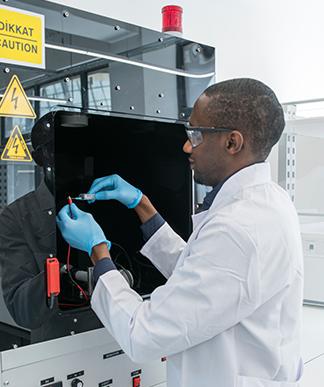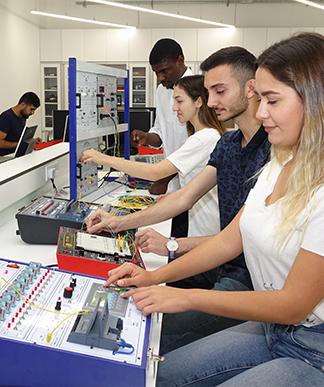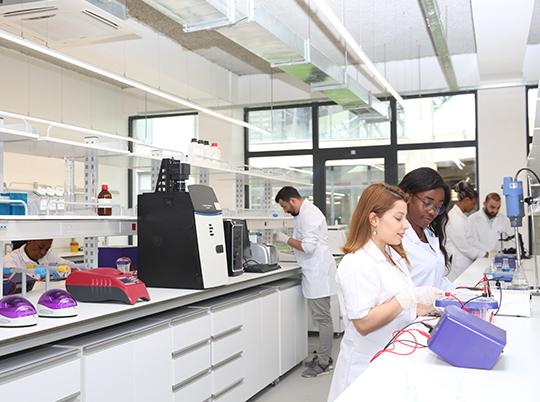


About the Program
Biomedical Engineering is an engineering field that works to solve the problems encountered in biology and medicine by taking advantage of the analytical experience of traditional engineering and aims to make general progress in health care. The field of Biomedical Engineering is to comprehend the structures of the components in the human body, to examine their working forms and interactions, and to develop the necessary tools and devices for functional disorders. Biomedical engineering, which provides a bridge between health and life through theoretical and applied engineering sciences, also covers interdisciplinary studies such as medicine, material engineering, computer engineering, electrical-electronics engineering, physics, chemistry, biology and so on. The language of instruction of the Biomedical Engineering Undergraduate Program is English. The graduates of the program are awarded the title of Biomedical Engineer. In addition to theoretical knowledge, most of the courses given during the 4-year education are supported by laboratory applications, project applications and internship programs.
Education Opportunities
Biomedical engineers' work area is widespread with topics, including the design of devices and software, compiling information from many technical sources and developing new procedures in clinical research to solve clinical problems. In the curriculum of Biomedical Engineering, there are basic science courses such as physics, chemistry, biology, mathematics and materials science. In addition, there are basic engineering courses such as Thermodynamics and Project Management and there are also Electrical and Electronics Engineering courses such as Circuit Theory, Signals and Systems, Electronics and Biomechanics, Bio-electricity, Clinical Engineering, Medical Imaging, Medical Devices and Biomedical Device Design. Our students have the opportunity to apply the knowledge they have gained through summer internship programs and graduation projects. The majority of the courses in the curriculum includes laboratory applications, and these applications are carried out in laboratories equipped with advanced technology devices within the Faculty of Engineering.

Career Areas
The need for personnel with technical and scientific knowledge to carry out design and development efforts of biomedical systems, and to take part in the efficient use of these systems is increasing day by day. Biomedical Engineers can work as design engineers in state or private sector healthcare institutions (hospitals, treatment and diagnostic centers, etc.) and medical device manufacturing organizations. They can also work as an engineer of quality control in the production process of these devices. In addition, they can work as a support engineer of medical devices in after-sales support units of organizations that supply medical devices, materials and equipment. They can carry out activities such as the calibration and simulation of these systems in institutions performing functions, such as the supervision of the devices used by the state and private health institutions and infrastructure systems related to them, and the planning of the investments related to these. They can also take part in the provision of necessary training for medical devices, and medical technologies in simulation centers within the Ministry of Health, state and private health institutions.
Contact
Faculty of Engineering
Science and Technology Center, ST 226
Tel: +90 392 671 1111 Extension: 2401
Faculty E-mail: secretary-fe@ciu.edu.tr
Head of Department: Asst. Prof. Dr. Pwadubashiyi Coston PWAVODI
Head of Department E-mail: ppwavodi@ciu.edu.tr
Compulsory Courses
First Semester
INTRODUCTION TO BIOMEDICAL ENGINEERING
Course code
BIME100Credit
0Theoretical
1Practical
0Ects
4GENERAL CHEMISTRY
Course code
CHEM110Credit
4Theoretical
3Practical
2Ects
6INTRODUCTION TO COMPUTING
Course code
CMPE101Credit
3Theoretical
2Practical
2Ects
4ENGINEERING DRAWING
Course code
CVLE101Credit
3Theoretical
2Practical
3Ects
5READING AND WRITING SKILLS-I
Course code
ENGL141Credit
3Theoretical
2Practical
2Ects
4CALCULUS-I
Course code
MATH101Credit
3Theoretical
3Practical
1Ects
6Second Semester
GENERAL BIOLOGY FOR ENGINEERS
Course code
BIOE112Credit
4Theoretical
3Practical
2Ects
7INTRODUCTION TO PROGRAMMING
Course code
CMPE111Credit
4Theoretical
3Practical
2Ects
6READING AND WRITING SKILLS-II
Course code
ENGL142Credit
3Theoretical
2Practical
2Ects
4CALCULUS-II
Course code
MATH102Credit
3Theoretical
3Practical
1Ects
6GENERAL PHYSICS-I
Course code
PHYS101Credit
4Theoretical
3Practical
2Ects
6TURKISH LANGUAGE
Course code
TREG100Credit
0Theoretical
2Practical
0Ects
2TURKISH
Course code
TURK100Credit
0Theoretical
2Practical
0Ects
2Third Semester
BIOMATERIALS AND DRUG DELIVERY
Course code
BIOE225Credit
3Theoretical
3Practical
0Ects
4DIGITAL LOGIC DESIGN
Course code
EELE221Credit
4Theoretical
3Practical
2Ects
7HISTORY OF CIVILIZATION
Course code
HIST100Credit
0Theoretical
2Practical
0Ects
2DIFFERENTIAL EQUATIONS
Course code
MATH203Credit
3Theoretical
3Practical
1Ects
6GENERAL PHYSICS-II
Course code
PHYS102Credit
4Theoretical
3Practical
2Ects
6MODERN TURKISH HISTORY
Course code
TARH100Credit
0Theoretical
2Practical
0Ects
2UNIVERSITY ELECTIVE
Course code
UNIEXX1Credit
3Theoretical
3Practical
0Ects
5Fourth Semester
ANATOMY -PHYSIOLOGY-I
Course code
ANAT110Credit
3Theoretical
3Practical
0Ects
6CIRCUIT THEORY I
Course code
EELE211Credit
4Theoretical
3Practical
2Ects
6ELECTROMAGNETIC THEORY I
Course code
EELE234Credit
3Theoretical
3Practical
1Ects
6ENGINEERING ECONOMY
Course code
INDE232Credit
3Theoretical
3Practical
0Ects
5LINEAR ALGEBRA
Course code
MATH121Credit
2Theoretical
2Practical
0Ects
4BIOSTATISTICS
Course code
STAT110Credit
2Theoretical
2Practical
0Ects
3Fifth Semester
BIOMECHANICS
Course code
BIME303Credit
3Theoretical
3Practical
0Ects
5BIOMEDICAL ENGINEERING AND INSTRUMENTATION
Course code
BIME309Credit
3Theoretical
2Practical
2Ects
5AREA ELECTIVE
Course code
BIMEXX1Credit
3Theoretical
3Practical
0Ects
6ELECTRONICS I
Course code
EELE341Credit
4Theoretical
3Practical
2Ects
6FREE ELECTIVE
Course code
FREEXX1Credit
4Theoretical
3Practical
2Ects
7Sixth Semester
PRINCIPLES OF MEDICAL IMAGING
Course code
BIME304Credit
3Theoretical
3Practical
0Ects
5INTRODUCTION TO MICROCONTROLLERS
Course code
BIME308Credit
4Theoretical
3Practical
2Ects
7BIOELECTRICITY
Course code
BIME310Credit
3Theoretical
3Practical
0Ects
5FREE ELECTIVE
Course code
FREEXX2Credit
4Theoretical
3Practical
2Ects
7FREE ELECTIVE
Course code
FREEXX3Credit
3Theoretical
3Practical
0Ects
7Seventh Semester
SUMMER TRAINING
Course code
BIME300Credit
0Theoretical
0Practical
0Ects
5ADVANCED MEDICAL DEVICE DESIGN
Course code
BIME401Credit
3Theoretical
3Practical
0Ects
5MODELING AND SIMULATION
Course code
BIME415Credit
3Theoretical
2Practical
2Ects
4AREA ELECTIVE
Course code
BIMEXX2Credit
3Theoretical
3Practical
0Ects
6PROJECT MANAGEMENT
Course code
ENGI401Credit
3Theoretical
3Practical
0Ects
5UNIVERSITY ELECTIVE
Course code
UNIEXX2Credit
3Theoretical
3Practical
0Ects
5Eighth Semester
AREA ELECTIVE
Course code
BIMEXX3Credit
3Theoretical
3Practical
0Ects
6AREA ELECTIVE
Course code
BIMEXX4Credit
3Theoretical
3Practical
0Ects
6TISSUE ENGINEERING
Course code
BIOE404Credit
3Theoretical
3Practical
0Ects
5CAPSTONE PROJECT
Course code
ENGI402Credit
4Theoretical
2Practical
4Ects
8UNIVERSITY ELECTIVE
Course code
UNIEXX3Credit
3Theoretical
3Practical
0Ects
5Elective Courses
MATERIALS SCIENCE
Course code
CVLE224Credit
4Theoretical
4Practical
1Ects
6THERMODYNAMICS
Course code
ENRE212Credit
4Theoretical
3Practical
2Ects
7ARTIFICIAL ORGANS
Course code
BIME404Credit
3Theoretical
3Practical
0Ects
PHYSIOLOGICAL SIGNALS AND INSTRUMENTATION
Course code
BIME302Credit
4Theoretical
3Practical
2Ects
6THERAPEUTIC MEDICAL DEVICES
Course code
BIME306Credit
3Theoretical
3Practical
0Ects
6MODERN TECHNICS IN BIOCHEMICAL ENGINEERING
Course code
BIOE323Credit
3Theoretical
3Practical
0Ects
SURGICAL INSTRUMENTATION
Course code
BIME402Credit
3Theoretical
3Practical
0Ects
INDUSTRIAL MICROBIOLOGY
Course code
BIOE302Credit
3Theoretical
3Practical
0Ects
WORLD ENERGY POLITICS
Course code
PNGE451Credit
3Theoretical
3Practical
0Ects
0PROGRAMMING IN MATLAB FOR ENGINEERING
Course code
ENGI316Credit
3Theoretical
3Practical
0Ects
ETHICS
Course code
INDE335Credit
3Theoretical
3Practical
0Ects
4INTEGRATED DOWNSTREAM PROCESSING
Course code
BIOE306Credit
3Theoretical
3Practical
0Ects
6BIOPROCESS ENGINEERING
Course code
BIOE308Credit
4Theoretical
3Practical
2Ects
7COMPUTER AIDED DESIGN
Course code
MCLE475Credit
3Theoretical
2Practical
3Ects
6SURGICAL INSTRUMENTATION
Course code
MEDE402Credit
3Theoretical
3Practical
0Ects
CONVENTIONAL AND ALTERNATIVE ENERGY RESOURCES
Course code
PNGE452Credit
3Theoretical
3Practical
0Ects
0TOTAL QUALITY MANAGEMENT
Course code
INDE428Credit
3Theoretical
3Practical
0Ects
HAZARDOUS AND SPECIAL WASTE MANAGEMENT
Course code
ENVE431Credit
3Theoretical
3Practical
0Ects
5ENVIRONMENTAL IMPACT ASSESSMENT
Course code
ENVE402Credit
3Theoretical
3Practical
0Ects
COMPUTER AIDED DATA ANALYSIS
Course code
INDE491Credit
3Theoretical
3Practical
0Ects
IOT FOR ENGINEERING
Course code
ENGI416Credit
3Theoretical
2Practical
2Ects
5ARTIFICIAL INTELLIGENCE
Course code
CMPE415Credit
3Theoretical
3Practical
1Ects
7ENERGY EFFICIENCY AND MANAGEMENT
Course code
ENRE313Credit
3Theoretical
3Practical
0Ects
5ENVIRONMENTAL POLLUTION AND ECOLOGY
Course code
ENVE308Credit
3Theoretical
3Practical
0Ects
ELECTROPHYSIOLOGY
Course code
BIOE493Credit
3Theoretical
3Practical
0Ects
MIDDLE EAST ENERGY OUTLOOK
Course code
PNGE415Credit
3Theoretical
3Practical
0Ects
5SUPPLY CHAIN AND LOGISTICS MANAGEMENT
Course code
INDE461Credit
3Theoretical
3Practical
0Ects
0ENVIRONMENTAL MANAGEMENT
Course code
ENVE407Credit
3Theoretical
3Practical
0Ects
5TR Applicants
TR Students who are successful in the exams conducted by the Higher Education Council Student Selection and Placement Center (ÖSYM) and are entitled to enroll in our university in line with their preferences can complete the registration process with the necessary documents for registration from our Registration and Liaison Offices throughout Turkey or from the Marketing Directorate on campus.
Click for detailed admission requirements information.
TRNC Applicants
TRNC citizens and TR citizen candidate students who have completed their entire high school education in TRNC. They are placed in undergraduate programs in line with their success in the CIU Student Placement and Scholarship Ranking Exam and the programs they prefer.
Students who are successful in the exam can register from the TRNC Marketing Office.
Applicants can directly apply online to our undergraduate programs using the application portal. Please fill in your details correctly and upload all the required documents listed on the last page of the application form.
Required documents;
- Completed application form,
- Higher/Secondary Certificate or equivalents (e.g. O/A’Level, WAEC/NECO),
- Evidence of English Language competence: TOEFL (65 IBT) or IELTS (5.5). Students without these documents will take the CIU English proficiency exam on campus following arrival,
- Scanned copy of international passport/birth certificate,
- Fully completed and signed CIU Rules and Regulations document (which can be downloaded during the online application).
Cyprus International University provides academic scholarships for its students as an incentive for success, with most students benefiting from 50%, 75% or 100% scholarships or discounted tuition fees. Click for more information.
Tuition Fees are determined at the beginning of each academic year. Candidate students who are entitled to enroll in CIU can learn their fees in line with the Tuition Fee Calculation system.